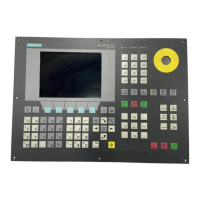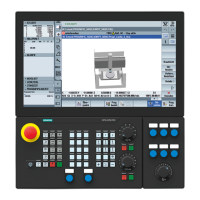● No distinction is made between uppercase and lowercase type.
●
String variables are generally displayed left justified.
Strings can be deleted simply by assigning a blank string.
Strings can be appended after the equality sign using the operator "<<". Quotation marks (")
in the string are represented by two successive quotation mark symbols. Strings can be
checked for equality in IF instructions.
Example
Default settings for the following examples:
VAR1.VAL = "This is an"
VAR8.VAL = 4
VAR14.VAL = 15
VAR2.VAL = "Error"
$85001 = "This is an"
$85002 = "Alarm text"
Editing strings:
● Chaining of strings:
VAR12.VAL = VAR1 << " Error." ;Result: "This is an error"
● Deleting a variable:
VAR10.VAL = "" ;Result: Blank string
● Setting a variable with a text variable:
VAR11.VAL = VAR1.VAL ;Result: "This is an"
● Data type matching:
VAR13.VAL ="This is the " << (VAR14 - VAR8) << ". error"
;Result: "This is the 11th error"
● Treatment of numerical values:
VAR13.VAL = "Error" << VAR14.VAL << ": " << $85001 << $85002
;Result: "Error 15: "This is an alarm text"
IF VAR15 == "Error" ;Strings in IF statement
VAR16 = 18.1234
;Result: VAR16 equals 18.1234,
;if VAR15 equals "Error".
ENDIF
● Quotation marks within a string:
VAR2="Hello, this is a " Test""
;Result: Hello, this is a " Test"
● System or user-variable strings dependent on variable content:
VAR2.Var = "$R[" << VAR8 << "]" ;Result: $R[4]
See also
STRING functions (Page 151)
Variables
5.15 Use of strings
SINUMERIK Integrate Run MyScreens
Programming Manual, 10/2015, 6FC5397-3DP40-5BA3 81

